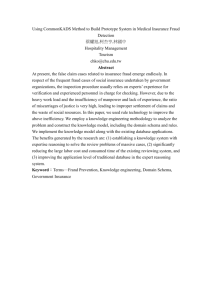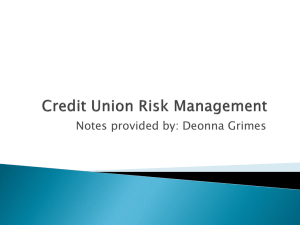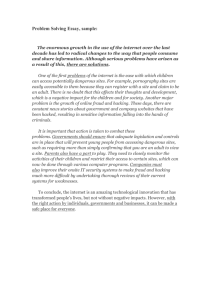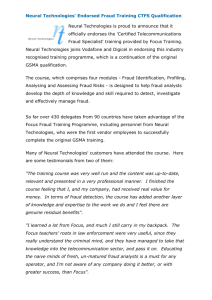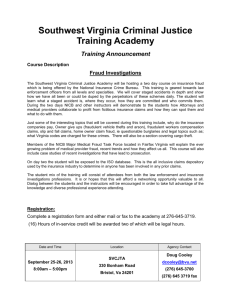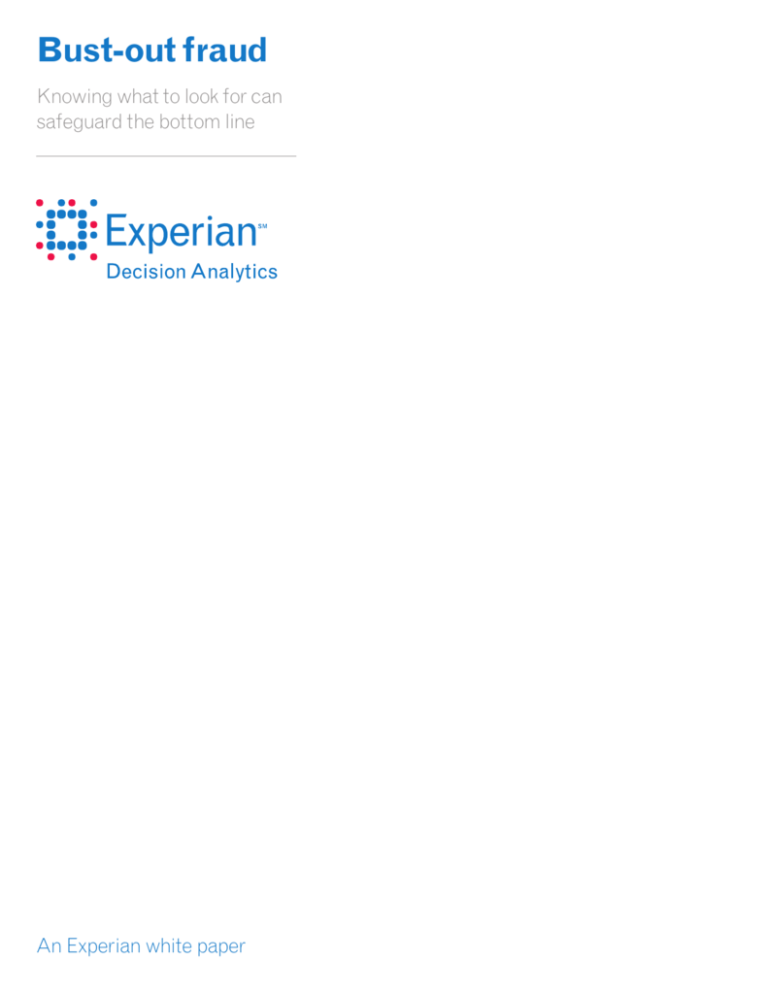
Bust-out fraud
Knowing what to look for can
safeguard the bottom line
An Experian white paper
Bust-out fraud
Executive summary
Bust-out is a growing area of fraud for the financial services industry.
For organizations across the globe, bust-out fraud is not a new problem.
However, despite continuous efforts to fight this crime, the losses incurred
continue to increase.
Identification of bust-out fraud is difficult for many organizations, as traditional
fraud tools in the market are primarily designed to detect third-party fraud, which
is associated with stolen identities. Sophisticated credit grantors typically rely on
“homegrown” systems that use internal data, such as customers’ current account
behaviors, transaction patterns and payment patterns, to detect bust-out. Even
though credit reporting agency data is used when manually reviewing suspicious
bust-out accounts, it generally is not used as the leading method of detection.
However, Experian’s research shows that credit reporting agency trend data is a
strong predictor of bust-out fraud and should be incorporated as a predictive tool
to detect and prevent this high-loss activity.
This white paper focuses on how bust-out is perpetrated, its characteristics and
how it can be detected by using credit data.
An Experian white paper | Page 1
Bust-out fraud
1. Introduction: Bust-out
Bust-out fraud, also known as sleeper fraud, is primarily a first-party fraud scheme.
It occurs when a consumer applies for and uses credit under his or her own name,
or uses a synthetic identity, to make transactions. The fraudster makes on-time
payments to maintain a good account standing, with the intent of bouncing a final
payment and abandoning the account.
During the process, the fraudster builds up a history of good behavior with timely
payments and low utilization. Over time, he or she obtains additional lines of credit
and requests higher credit limits. Eventually, the fraudster uses all available credit
and stops making payments. Overpayments with bad checks are often made in the
final stage of the bust-out, temporarily inflating the credit limit and causing losses
greater than the account credit limit.
Apply for credit
Build good
credit history
Obtain additional
credit
Draw down all
available credit
Disappear
Bankcards are bust-out fraudsters’ favorite medium. However, some fraudsters
also utilize retail cards, home-equity lines of credit, and other secured and unsecured
loans. Perpetrators typically apply for credit four to 24 months before busting out.
The typical bust-out life cycle has a period of “clean/fictitious” behavior preceding
a period of “bad” behavior.
Page 2 | Bust-out fraud: Knowing what to look for can safeguard the bottom line
Bust-out fraud
The chart below shows how bust-out occurs over time and some of the attributes
associated with this behavior.
Bust-out life cycle
12
Peak of 10.3
open bankcards
month prior to
bust-out
10
Utilization
peaks at time
of bust-out
8
Delinquencies
quickly rise to
peak of 7.2 cards
6
Bust-out
preceded by
sharp increase
in inquiries
4
2
0
-15
-12
-9
-6
-3
0
3
6
9
12
15
Months relative to bust-out
Number of bankcard
inquires in last 12 months
Number of bankcards
with 50%+ utilization
Number of open bankcards
Number of bankcard
trades ever 60+ DPD
All four attributes change significantly right before the bust-out behavior occurs.
1. Bankcard inquiries increase steadily over time, starting at an average of two
inquiries approximately 15 months before the bust-out. About three months
before bust-out, inquiries increase, peaking at about seven.
2. Bankcard accounts increase steadily over time. Fifteen months prior to bust-out,
the fraudster holds an average of seven cards. Three months before bust-out,
that number increases to an average of 10 bankcards.
3. Credit utilization remains steady until three months prior to the fraud,
at which time it increases significantly.
4. No delinquencies occur until the point of bust-out, and then, like credit utilization,
they increase dramatically.
An Experian white paper | Page 3
Bust-out fraud
The inquiries and bankcard behavior demonstrate that the fraudsters are gaining
access to as much credit as possible prior to committing the bust-out fraud. They
maintain the credit accounts in good standing in order to maximize the amount of
credit available at the time of bust-out.
After the bust-out and delinquencies occur, the fraudsters often attempt to obtain
more bankcards, as evidenced by continuing inquiries. However, this effort is to no
avail. Reports show a declining number of open accounts.
2. The cost of bust-out fraud
Losses incurred from bust-out fraud are significant. U.S. card issuers estimate their
losses from this type of fraud to be more than $1.5 billion annually. (Source: Credit
Risk International, September 2004)
The above-stated loss represents only 1 percent of the industry’s annual revenue.
As such, detection and prevention efforts have yet to increase to a level that would
deter fraudsters. However, some fraudsters are being caught. In April 2004, the FBI
estimated that an organized bust-out crew had accrued $6.8 million in profit from
1995 to 2003.
Major banks have reported an increase in credit loss reserves in the last several
years. Even though some of it can be blamed on rising indebtedness and a global
economic slowdown, the increase in fraud is also a major factor. Anecdotal
evidence suggests that several banks consider bust-out fraud a rising problem
that contributes to the increase of bad debts.
Experian’s research indicates that there are 100 to 200 bust-out accounts per year
for every million accounts. That means for a large bank with 10 million customers,
there are approximately 1,000 to 2,000 cases of bust-out annually.
The losses associated with bust-out are more than those that associated with
nonfraudulent write-offs. The bad check with overpayment submitted at the last
stage of bust-out temporarily inflates the credit limit, causing the damage to reach
more than 100 percent of the original credit limit. In contrast, defaults and losses due
to consumer financial distress rarely include inflated bad payments.
Page 4 | Bust-out fraud: Knowing what to look for can safeguard the bottom line
Bust-out fraud
3. Bust-out defined
Defining factors
Bust-out fraud is not a new problem in the credit industry. It has been reported
to Experian that the number of confirmed bust-outs for an issuer has increased
twofold from 2005 to 2007. However, despite this issue’s significance, there is no
industry-standard definition of what constitutes bust-out fraud. This is largely due
to the varying behavior patterns displayed by fraudsters. Some credit grantors
have a very restrictive definition, such as the account must exceed its credit limit
or display an unusual purchase pattern at particular high-risk merchant locations.
Conversely, some credit issuers do not have a bust-out definition. The danger of
defining bust-out too narrowly is that lenders will exclude the accounts that do
not strictly follow the typical pattern, thus leading the true bust-out account to be
treated inappropriately. Conversely, having too broad of a definition will include
regular credit losses in the bust-out cycle. For the purpose of Experian’s analysis and
development, bust-out has the following characteristics:
• Account is 90 days or more delinquent
• Balance is close to or over the credit limit (70 percent or above)
• Payment has been returned, i.e., a bad or nonsufficient-fund check
was submitted
• The account holder cannot be reached using the address or phone
number provided
• The same condition exists in more than one account either at one
or multiple institutions
The first three criteria are similar to those of regular credit losses. Consumers
in financial distress with no intention to defraud often have delinquent accounts
and high credit utilization. Also, a bounced payment or two is not uncommon.
Consequently, the last two criteria are added to imply intention of bust-out. Incorrect
phone numbers and addresses provided by account holders could indicate intention
to commit fraud or abandon the account. Also, the likelihood of a true bust-out is
high if the account holder has the same condition across multiple organizations.
Bust-out fraud characteristics
Even though bust-out fraudsters do not always follow a distinct behavior pattern,
it is still important to understand their behaviors collectively. In Experian’s analysis,
we looked for common characteristics of bust-out fraud. There are two groups of
bust-outs in this category. The first group includes accounts that were actively shut
down due to bust-out activities. The second group includes accounts that were never
flagged but were then categorized as bust-out at the time of charge-off. These bustout attributes are calculated three months prior to shutting down or charging off.
To understand the figures, we dug deep into the individual characteristics of the
bust-out accounts compared with those of non-bust-out profiles with clean credit
histories, as well as the national average for the U.S. population.
An Experian white paper | Page 5
Bust-out fraud
Length of credit history
The expectation may be that bust-out fraudsters have limited credit experience,
i.e., thin-file consumers. However, the study indicates that the average age of the
oldest trade in a bust-out profile is 98 months (8.2 years), with a median of 79 months
(6.6 years). In other words, bust-out accounts do not necessarily have thin files.
While bust-out profiles are not as robust in length as the average accounts, they are
not primarily thin-file consumers nor do they have limited consumer histories.
Age of oldest trade
250
Months
200
150
100
50
205
98
146
0
Good accounts
Bust-outs
National average
Viewed from a different angle, these accounts do have the youngest trades.
On average, the youngest trade bust-out fraudsters have is just 6 months old,
compared with 9.7 months for the good account holders. For the rest of the
population, the youngest trade is 35.6 months (2.9 years) old, indicating that
both good account holders and bust-out fraudsters are more active in obtaining
new financial obligations.
Age of most recently opened trade
40
35
Months
30
25
20
15
10
5
9.7
6.0
35.6
0
Good accounts
Bust-outs
Page 6 | Bust-out fraud: Knowing what to look for can safeguard the bottom line
National average
Bust-out fraud
Credit activity
It’s not surprising that bust-out fraudsters are more credit-active than the
average consumer. Over a period of 12 months, bust-out fraudsters are almost
three times more credit-active than good account holders, with an average of
2.9 trades opened versus only 1.1 trades in the good account population. At three
months prior to bust-out, the fraudsters have obtained as many credit lines as
possible. In contrast, the national average actually has fewer trades than both
the bust-outs and the good accounts.
Number of trades opened in last 12 months
3.5
3.0
2.5
2.0
1.5
1.0
0.5
1.10
2.90
0.81
0.0
Good accounts
Bust-outs
National average
Bankcard as a bust-out medium
A bankcard is one of the easiest loans to obtain. Requiring no collateral, issuers
make the application process quick and convenient. Presenting themselves as
typical consumers, bust-out fraudsters acquire as many bankcards as possible. In
our study, we looked at the number of bankcards as a percentage of total open trades.
On average, 64 percent of bust-out fraudsters’ profiles are made up of bankcards,
compared with only 51 percent in the typical population. This is not only because
cards are bust-out fraudsters’ favorite medium, but also because they usually have
fewer other financial relationships, such as real estate and auto tradelines.
Percentage of bankcard to total open trades
70%
60%
50%
40%
30%
20%
10%
51%
64%
51%
0%
Good accounts
Bust-outs
National average
An Experian white paper | Page 7
Bust-out fraud
From another angle, we also see that bust-out fraudsters have almost five times as
many inquiries as the good accounts, with 5.23 bankcard inquiries compared with
only 1.07 in good accounts. This information shows that the bust-out fraudsters
actively apply for credit cards.
Number of bankcard inquiries
6.0
5.0
4.0
3.0
2.0
1.0
1.07
5.23
0.44
0.0
Good accounts
Bust-outs
National average
Other financial obligations
As we mentioned, bust-out fraudsters tend to have fewer nonbankcard financial
relationships. For example, they have, on average, 0.5 real property trades
(mortgages, home improvement, mobile homes and second mortgages) compared
with 1.7 and 0.83 trades observed in good accounts and in the national average,
respectively. This finding is in line with the common belief that bust-out fraudsters
do not typically own properties. At the same time, however, this figure also implies
that we should not expect them to have absolutely no property loans.
Number of real property trades
1.8
1.6
1.4
1.2
1.0
0.8
0.6
0.4
0.2
1.70
0.50
0.83
0.0
Good accounts
Bust-outs
Page 8 | Bust-out fraud: Knowing what to look for can safeguard the bottom line
National average
Bust-out fraud
Similarly, a typical perception is that bust-out fraudsters mainly take advantage of
unsecured loans and do not obtain loans that require collateral. However, mobile
collateral might be an exception. As the chart below demonstrates, bust-out
fraudsters have 0.9 auto trades. Even though this figure is half that of good accounts
(1.8 trades), the number is only slightly lower than the national average (0.97). The
difference between bust-out accounts and the national average is not very pronounced.
Total number of auto trades
2.0
1.8
1.6
1.4
1.2
1.0
0.8
0.6
0.4
0.2
1.80
0.90
0.97
0.0
Good accounts
Bust-outs
National average
Bust-out fraudsters also tend to have fewer credit union relationships, as illustrated
in the chart below. With only 0.3 credit union trades, they have three times fewer than
that of good accounts.
Total number of credit union trades
1.0
0.9
0.8
0.7
0.6
0.5
0.4
0.3
0.2
0.1
0.9
0.3
0.5
0.0
Good accounts
Bust-outs
National average
An Experian white paper | Page 9
Bust-out fraud
4. Detecting and predicting bust-out fraud
Identification of bust-out fraud
The identification of bust-out is difficult for many organizations given the uncertain
timing and suddenness of the bust-out event. Traditional third-party fraud tools are
not effective in tackling bust-out fraud, as these tools focus on detecting stolen or
fictitious identities at the point of account origination. Because bust-out perpetrators
often use their own identities, they usually obtain credit without concern.
Some lenders monitor their customers’ transactions using suspicious activity
triggers to review the accounts. Examples of suspicious activities are frequent
convenience checks; frequent cash advances; multiple payments within one billing
period from different accounts and different sources; purchases from high-risk,
high-value merchants; and unusual purchase amounts (e.g., $1,000 at a dry cleaner).
Some issuers use these factors in models to predict bust-outs.
Upon detecting these high-risk bust-out triggers, investigators often conduct a
manual account review. In addition to evaluating transaction and payment activities,
the investigators also may pull the account holders’ credit reports to assess
activities with other creditors. In other words, credit data typically is retrieved
during investigation but is not used as the leading indicator of bust-out.
Conversely, Experian’s research and analysis shows that credit data provides
tremendous insight into high-risk bust-out behaviors. Using only credit data,
Experian developed its BustOut Score, which demonstrates superior ability
to detect and predict bust-out fraud.
®
SM
Scoring development
BustOut Score was developed in collaboration with several leading U.S. card issuers
using a three-month development window and a consistent definition of bust-out. For
development purposes, bust-out was defined as having the following characteristics:
• A delinquent account (more than 90 days)
• A balance close to or over the limit
• A returned payment
• Failed attempts to reach the customer
Using this definition, 27,000 bust-out cases were collected from various
bankcard issuers.
The following observations were made:
• It is possible to produce bust-out models with good discrimination
• The model is predictive using only credit data
Page 10 | Bust-out fraud: Knowing what to look for can safeguard the bottom line
Bust-out fraud
• The Kolmogorov-Smirnov (KS) value is 72 (KS measures the maximum
separation in the cumulative distributions of the good and bad populations)
• For the worst-scoring 1 percent of the population, approximately 50 percent
of bust-outs were identified
• For the worst-scoring 0.5 percent of the population, approximately 40 percent
of bust-outs were identified
BustOut Score performance
100
90
Percentage of bad accounts
80
70
60
50
40
30
20
10
0
0
1
2
3
4
5
6
7
8
9
10
Percentage of good accounts
While some false positives are expected with this score, we found that the false
positives delivered by the model are accounts that are at high risk for delinquency
(i.e., bad credit accounts) and still would benefit from review/action.
To understand the impact of detecting bust-outs three months before the bust-out
date, we looked at the utilizations and balance trends of select customers throughout
the bust-out life cycle. We also applied the BustOut Score at a monthly interval
starting five months prior to the typical detection date.
An Experian white paper | Page 11
Bust-out fraud
Utilization and balance
300
BustOut
Score at -3
months is 861
250
200
800
Optimal
window
to utilize
score
150
Score
Percentage utilized
850
Utilization at
typical time of
detection is 170%
with balance of
$67,780
750
100
Savings if stopped at
-3 months: balance
$64,000/160% growth
Utilization at -3
months is 10% with
balance of $3,600
50
700
650
0
-5
-4
-3
-2
-1
0
1
Months relative to bust-out
Overall balance-to-limit
ratio (utilization)
BustOut Score
SM
In this example, the BustOut Score rose sharply three months prior to the
detection date, at which point the utilization and balance still remained relatively
low at 10 percent and $3,600. A BustOut Score applied to this scenario would have
alerted the issuer to the potential bust-out three months earlier — at the 10 percent
utilization point — instead of at the 170 percent utilization point with a balance
of $67,780.
Page 12 | Bust-out fraud: Knowing what to look for can safeguard the bottom line
Bust-out fraud
Conclusion
Credit data brings increased predictability to the analysis of bust-out that internal
data alone cannot provide. Issuers that only utilize internal transaction and payment
data see only account activities in their own organization, such as suspicious
purchases, cash advances, convenience checks, credit line increases and suspicious
payments. With the exception of the credit line increase request, these activities
usually happen close to the actual bust-out event, eliminating proactive action to
prevent the bust-out scheme and, ultimately, the losses.
Credit reporting data provides a perspective on how account holders behave across
the credit spectrum. Behaviors such as credit line increases, new accounts, changes
in utilization and balance growth can all be captured through credit reporting data.
By generating a wider perspective, the bust-out predictors can be observed months
before the bust-out is executed. Including credit data in the prediction of bustout fraud brings a 360-degree view of the consumer and relevant credit activities.
Comprehensive data that identifies target behaviors in advance of the fraudulent
activities allows lenders to better protect against substantial losses associated with
the growing bust-out issue.
Experian’s BustOut Score
SM
Experian has developed a score specifically designed to assist institutions in
identifying potential bust-out schemes three months before the intended bustout date. Experian’s BustOut Score is easily incorporated into an existing riskmanagement process without significant technological investment. Utilizing the
BustOut Score, either at account opening or account origination, will improve
operational efficiencies by quickly clearing low-risk accounts, reducing manual
review requirements and promoting positive customer experiences with a reduced
false-positive rate.
SM
For more information, please contact Experian at 1 888 414 1120.
An Experian white paper | Page 13
Experian
475 Anton Blvd.
Costa Mesa, CA 92626
www.experian.com
© 2009 Experian Information Solutions, Inc. • All rights reserved
Experian and the marks used herein are service marks or
registered trademarks of Experian Information Solutions, Inc.
Other product and company names mentioned herein may
be the trademarks of their respective owners.
01/09 • 2000/1046 • 4942-CS

